Exchange Currency
Nepalese rupee
The rupee is the official currency of Nepal. It is subdivided into 100 paisa. The issuance of the currency is controlled by the Nepal Rastra Bank. The most commonly used symbol for the Rupee is Rs or ₨.
The Kingdom of Nepal was unified on September 25, 1768 by Prithvi Narayan, the Shah ruler of the kingdom of the Gorkhas. From 1775 to 1951 Nepali politics was characterized by conflict between the royal family and several noble families. The British conquest of India forced the Nepali rulers to seek an accommodation with the British to preserve their independence.
Nepal issued Gold Mohar (NPM) and silver Dabals, but a scarcity of coins led to the introduction of Indian Rupees (INR) in the 1800s. The Gold Mohar was divisible into 30 Silver Mohars or 1500 Paisa. The silver Mohar had the same weight as the Indian Rupee and was at par with it.
The Nepal Rupee replaced the Mohar/Paisa in 1932. Since the Nepal Rupee had a lower silver content than the Mohar, it traded at a slight discount to the Indian Rupee with 1.28 Nepal Rupees = 1 Indian Rupee in the 1920s, 1.54 Nepalese Rupees by 1939, but appreciated to 0.65 Nepalese Rupees during World War II. In 1951, Nepal issued its first banknotes, denominated in Nepalese Rupees (NPR) which were valued at 1.28 Nepalese Rupees = 1 Indian Rupee, though the market rate was about 1.60 Nepalese Rupees = 1 Indian Rupee. The Rupee was divisible into 100 Paisa.
Because Nepalese citizens exchanged Nepalese coins for Indian currency, this created a drain on Nepals silver resources, leading to the introduction of Nepalese banknotes on June 1, 1945. The Government of Nepal issued banknotes from 1950 until 1960, and the Nepal Rastra Bank, established on April 26, 1956, has issued banknotes since 1960. The Foreign Exchange Regulation Act prohibited the use of Indian currency for internal payments, though the act was initially enforced only loosely outside of cities in the Kathmandu valley. By 17 October 1966, enforcement had spread to the whole country. The Indian rupee ceased to be legal tender on October 17, 1966.
Initially, the rupee was called the mohru in Nepalese. Its value was pegged to the Indian rupee in 1993 at a rate of 1.6 Nepalese rupees = 1 Indian rupee.
In 1966, aluminium 1, 2 and 5 paisa and brass 10 paisa were introduced. Aluminium 25 paisa coins were introduced in 1982, followed by stainless steel 50 paisa and 1 rupee in 1987 and 1988. In 1994, smaller 10 and 25 paisa coins were issued, alongside aluminium 50 paisa and brass-plated-steel 1, 2, 5 and 10 rupaiya.
The early banknotes which were issued between 1945 and 1955 during the rule of King Tribhuvan were not put into circulation by a Central Bank which did not exist in Nepal at that time. The issuing authority was the treasury which had the name Sadar Muluki Khana. Therefore the notes of king Tribhuvan were not signed by a bank governor, but by a Khajanchi (head of the treasury) who was a high Hindu priest in the same time. Nepal’s early paper currency probably includes the only notes of the world which were signed by a high priest. These early notes were printed by the Indian Security Press in Nashik and do not have any security features, except for the watermarks and the special paper on which they are printed.
Starting with King Mahendra who succeeded to his father Tribhuvan in 1955, the banknotes were issued by Nepal Rastra Bank (Nepal National Bank) which was founded in April 1956. The signature of the governors of this institution is found on the banknotes which were issued after this date. Under king Mahendra the Nepalese Government became “His Majesty’s Government” (expressed by "shri 5 ko sarkar" which literally means “the government of the five times honoured”) and remained this way during the rule of Birendra and Gyanendra. Two series of banknotes were issued during the rule of king Mahendra: The first series shows the king in civilian clothes wearing the Nepalese “topi” while on the notes of the second series the king is shown in military uniform. The second series comprised for the first time notes of the high value of 500 and 1000 rupees.
During King Birendra’s rule one can also distinguish between two major series of banknotes. The first series features the king wearing military uniform while on the notes of the second series the king is wearing the traditional Nepalese crown adorned with feathers of the bird of paradise. During this period regular banknotes of 2 and 20 rupees and special banknotes of 25 and 250 rupees were issued for the first time.
The banknotes issued during this period have the same basic design as those of King Birendra whose portrait was simply replaced by that of his younger brother and successor Gyanendra. The low values of 1 and 2 rupees, and the special values of 25 and 250 rupees were not issued any more. The legends found on the last issues of Gyanendra revert to Nepal sarkar (“Nepalese Government”), thus omitting the reference to the king.
In October 2007 a 500 rupee note was issued on which the king’s portrait was replaced by Mt. Everest. This reflects the historical change from kingdom to republic which took place in May 2008 in Nepal. Further notes of 5, 10, 20, 50, 100 and 1000 rupees with Mt. Everest and without reference to the king in their legends followed in 2008. The first issues of the 500 and 1000 rupee notes were printed on paper which still had the king's crowned portrait as watermark in the "window" on the right part of the face of the notes. It was decided to print a red Rhododendron flower (Nepal's national flower) on top of the watermark. Notes of these denominations which were issued in 2009 and thereafter are printed on paper which has a Rhododendron flower as watermark instead of the royal portrait and were therefore released without the additional overprint in red.
Summary info
Summary information about Nepalese rupee- ISO 4217 Code:
- NPR
- Currency sign:
- Rs or रू
- Country:
- Nepal, India
- Subunit:
- paisa
- Coins:
- 1 paisa, 5 paisa, 10 paisa, 25 paisa, 50 paisa, 1 rupee, 2 rupees
- Banknotes:
- 5 rupees, 10 rupees, 20 rupees, 50 rupees, 100 rupees, 500 rupees, 1000 rupees
- Central bank:
- Nepal Rastra Bank
History
The first coins were not issued in Nepal until the sixth century AD when the Licchavi kingdom of Nepal issued copper coins bearing religious designs of Indian origin. Coins were infrequently issued between the eighth and seventeenth centuries. During the mid-seventeenth century, the three Malla kingdoms began issuing silver tankas in large quantities. Patan coins were distinguished by a star, Bhatgaon coins by a triangle and Kathmandu coins by wavy lines. During the mid-eighteenth century, Nepal issued the smallest gold coins ever used: gold 1/2048 mohars weighing 0.002 grams. Nepal exported their silver coins to Tibet until the late 1700s.The Kingdom of Nepal was unified on September 25, 1768 by Prithvi Narayan, the Shah ruler of the kingdom of the Gorkhas. From 1775 to 1951 Nepali politics was characterized by conflict between the royal family and several noble families. The British conquest of India forced the Nepali rulers to seek an accommodation with the British to preserve their independence.
Nepal issued Gold Mohar (NPM) and silver Dabals, but a scarcity of coins led to the introduction of Indian Rupees (INR) in the 1800s. The Gold Mohar was divisible into 30 Silver Mohars or 1500 Paisa. The silver Mohar had the same weight as the Indian Rupee and was at par with it.
The Nepal Rupee replaced the Mohar/Paisa in 1932. Since the Nepal Rupee had a lower silver content than the Mohar, it traded at a slight discount to the Indian Rupee with 1.28 Nepal Rupees = 1 Indian Rupee in the 1920s, 1.54 Nepalese Rupees by 1939, but appreciated to 0.65 Nepalese Rupees during World War II. In 1951, Nepal issued its first banknotes, denominated in Nepalese Rupees (NPR) which were valued at 1.28 Nepalese Rupees = 1 Indian Rupee, though the market rate was about 1.60 Nepalese Rupees = 1 Indian Rupee. The Rupee was divisible into 100 Paisa.
Because Nepalese citizens exchanged Nepalese coins for Indian currency, this created a drain on Nepals silver resources, leading to the introduction of Nepalese banknotes on June 1, 1945. The Government of Nepal issued banknotes from 1950 until 1960, and the Nepal Rastra Bank, established on April 26, 1956, has issued banknotes since 1960. The Foreign Exchange Regulation Act prohibited the use of Indian currency for internal payments, though the act was initially enforced only loosely outside of cities in the Kathmandu valley. By 17 October 1966, enforcement had spread to the whole country. The Indian rupee ceased to be legal tender on October 17, 1966.
Initially, the rupee was called the mohru in Nepalese. Its value was pegged to the Indian rupee in 1993 at a rate of 1.6 Nepalese rupees = 1 Indian rupee.
Coins
In 1932, silver 20 and 50 paisa and 1 rupee coins were introduced, followed by copper 1, 2 and 5 paisa between 1933 and 1935. In the 1940s, copper ¼ and ½ paisa and nickel-brass 5 paisa were added. In 1953, a new coinage was introduced consisting of brass 1, 2 and 4 paisa, bronze 5 and 10 paisa, and cupro-nickel 20, 25 and 50 paisa and 1 rupee. The 20 paisa was discontinued after 1954.In 1966, aluminium 1, 2 and 5 paisa and brass 10 paisa were introduced. Aluminium 25 paisa coins were introduced in 1982, followed by stainless steel 50 paisa and 1 rupee in 1987 and 1988. In 1994, smaller 10 and 25 paisa coins were issued, alongside aluminium 50 paisa and brass-plated-steel 1, 2, 5 and 10 rupaiya.
Banknotes
Between 1945 and 2007 Nepalese banknotes were issued with the portraits of four different kings. Starting in October 2007 the king’s portrait was replaced by Mount Everest on all notes which have been issued since.The early banknotes which were issued between 1945 and 1955 during the rule of King Tribhuvan were not put into circulation by a Central Bank which did not exist in Nepal at that time. The issuing authority was the treasury which had the name Sadar Muluki Khana. Therefore the notes of king Tribhuvan were not signed by a bank governor, but by a Khajanchi (head of the treasury) who was a high Hindu priest in the same time. Nepal’s early paper currency probably includes the only notes of the world which were signed by a high priest. These early notes were printed by the Indian Security Press in Nashik and do not have any security features, except for the watermarks and the special paper on which they are printed.
Starting with King Mahendra who succeeded to his father Tribhuvan in 1955, the banknotes were issued by Nepal Rastra Bank (Nepal National Bank) which was founded in April 1956. The signature of the governors of this institution is found on the banknotes which were issued after this date. Under king Mahendra the Nepalese Government became “His Majesty’s Government” (expressed by "shri 5 ko sarkar" which literally means “the government of the five times honoured”) and remained this way during the rule of Birendra and Gyanendra. Two series of banknotes were issued during the rule of king Mahendra: The first series shows the king in civilian clothes wearing the Nepalese “topi” while on the notes of the second series the king is shown in military uniform. The second series comprised for the first time notes of the high value of 500 and 1000 rupees.
During King Birendra’s rule one can also distinguish between two major series of banknotes. The first series features the king wearing military uniform while on the notes of the second series the king is wearing the traditional Nepalese crown adorned with feathers of the bird of paradise. During this period regular banknotes of 2 and 20 rupees and special banknotes of 25 and 250 rupees were issued for the first time.
The banknotes issued during this period have the same basic design as those of King Birendra whose portrait was simply replaced by that of his younger brother and successor Gyanendra. The low values of 1 and 2 rupees, and the special values of 25 and 250 rupees were not issued any more. The legends found on the last issues of Gyanendra revert to Nepal sarkar (“Nepalese Government”), thus omitting the reference to the king.
In October 2007 a 500 rupee note was issued on which the king’s portrait was replaced by Mt. Everest. This reflects the historical change from kingdom to republic which took place in May 2008 in Nepal. Further notes of 5, 10, 20, 50, 100 and 1000 rupees with Mt. Everest and without reference to the king in their legends followed in 2008. The first issues of the 500 and 1000 rupee notes were printed on paper which still had the king's crowned portrait as watermark in the "window" on the right part of the face of the notes. It was decided to print a red Rhododendron flower (Nepal's national flower) on top of the watermark. Notes of these denominations which were issued in 2009 and thereafter are printed on paper which has a Rhododendron flower as watermark instead of the royal portrait and were therefore released without the additional overprint in red.
NPR banknotes pictures gallery
| 5 Nepalese rupees | |
|---|---|
| Banknote of 5 Nepalese rupees has dimensions 120×70 mm and main colors are brick red, bisque, dark gray, bubble gum, desert sand, pale pink and pale silver. The banknote of the 5 Nepalese rupees was issued for the first time on the 5 June 2009. | |
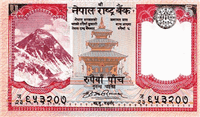 Obverse side of the 5 Nepalese rupees is showing an image with the Mount Everest and Goddess Taleju Temple. |
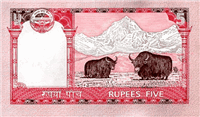 Reverse side of the 5 Nepalese rupees is showing an image with the Himalayan mountains, the Yaks (Bos grunniens) and the coat of arms. |
| 10 Nepalese rupees | |
|---|---|
| Banknote of 10 Nepalese rupees has dimensions 132×70 mm and main colors are khaki, rose ebony, platinum, languid lavender, moccasin, alice blue, honeydew and mint cream. The banknote of the 10 Nepalese rupees was issued for the first time on the 26 September 2008. | |
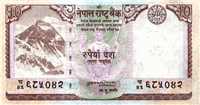 Obverse side of the 10 Nepalese rupees is showing the Mount Everest and image of Lord Changunarayan (a form of an appearance of Vishnu) on Garuda. |
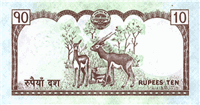 Reverse side of the 10 Nepalese rupees is showing the Blackbuck antelope (Antilope cervicapra) and the Coat of arms. |
| 20 Nepalese rupees | |
|---|---|
| Banknote of 20 Nepalese rupees has dimensions 140×70 mm and main colors are pale copper, french beige, pastel pink, champagne, pastel gray, timberwolf, almond and floral white. The banknote of the 20 Nepalese rupees was issued for the first time on the 8 May 2009. | |
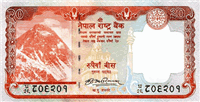 Obverse side of the 20 Nepalese rupees is showing an image of the Mount Everest and Lord Krishna in Lalitpur. |
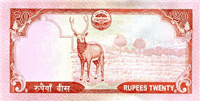 Reverse side of the 20 Nepalese rupees is showing an image with the Himalayan mountains, the Sambar (deer)(Cervus unicolor) and the coat of arms. |
| 50 Nepalese rupees | |
|---|---|
| Banknote of 50 Nepalese rupees has dimensions 142×70 mm and main colors are charcoal, air force blue, cadet grey, pale aqua, dark slate gray, lavender mist, pearl and snow. The banknote of the 50 Nepalese rupees was issued for the first time on the 23 September 2008. | |
 Obverse side of the 50 Nepalese rupees is showing an image with the Mount Everest and the Ram Janaki Temple in Janakpur. |
 Reverse side of the 50 Nepalese rupees is showing a tar and the coat of arms. |
| 100 Nepalese rupees | |
|---|---|
| Banknote of 100 Nepalese rupees has dimensions 148×70 mm and main colors are grullo, pale silver, battleship grey, cambridge blue, xanadu, pale spring bud and tea green. The banknote of the 100 Nepalese rupees was issued for the first time on the 29 September 2008. | |
 Obverse side of the 100 Nepalese rupees is showing an image of the Mount Everest, the Mounts Nuptse, Everest, Lhotse and Nyatapola Temple in Bhaktapur. |
 Reverse side of the 100 Nepalese rupees is showing the Indian Rhinoceros (Rhinoceros unicornis) and the coat of arms. |
| 500 Nepalese rupees | |
|---|---|
| Banknote of 500 Nepalese rupees has dimensions 160×70 mm and main colors are pale spring bud, wheat, aurometalsaurus, grullo, dim gray, manatee, beige and champagne. The banknote of the 500 Nepalese rupees was issued for the first time on the 20 September 2009. | |
 Obverse side of the 500 Nepalese rupees is showing an image of the Mount Everest left, the Mount Ama Dablam and Thyangboche monastery centre background, rhododendron over watermark. |
 Reverse side of the 500 Nepalese rupees is showing the Himalayan Tigers and the coat of arms. |
| 1000 Nepalese rupees | |
|---|---|
| Banknote of 1000 Nepalese rupees has dimensions 172×70 mm and main colors are light gray, timberwolf, rose quartz, lavender gray, gainsboro and silver. The banknote of the 1000 Nepalese rupees was issued for the first time on the 8 January 2010. | |
 Obverse side of the 1000 Nepalese rupees is showing an image of the Mount Everest, Swayambhunath and Harati Temples in Kathmandu. |
 Reverse side of the 1000 Nepalese rupees is showing an elephant and the coat of arms. |
Useful links
- About Nepal Rastra Bank:
- Nepal Rastra Bank
- List of currencies:
- Currencies
- Security and design features of NPR banknotes:
- NPR banknotes
- NPR currency on Wikipedia:
- Nepalese rupee
- Official Website of Nepal Rastra Bank:
- www.nrb.org.np
- Commemorative coins:
- Commemorative Coins